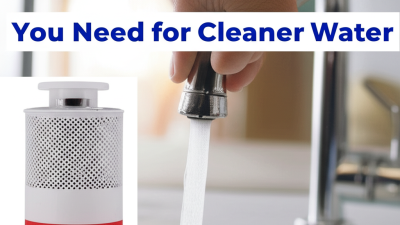As we move further into 2025, the demand for cleaner and safer drinking water continues to surge, prompting innovations in household water filtration technology. One such solution that has gained significant attention is the Faucet Aerator Filter. This compact yet effective device not only enhances water quality by reducing contaminants but also helps conserve water by aerating the flow.

In this blog post, we will explore the seven best faucet aerator filters currently on the market, detailing their features, benefits, and how they can seamlessly integrate into your daily life. Whether you're concerned about chlorine levels, sediment, or simply want to improve the taste of your tap water, these filters offer practical solutions to elevate your water quality.
Join us as we dive into the latest insights and trends that will shape the future of faucet aerator filters, ensuring you stay informed and equipped for a healthier lifestyle.
When selecting faucet aerator filters, it’s essential to understand the key features that signify quality and performance. According to the American Water Works Association, a high-quality aerator can significantly enhance water efficiency, reducing flow rates without sacrificing performance. Opt for those labeled with a low-flow rate of 1.5 GPM or lower to align with industry standards focused on conservation. Additionally, look for filters with removable and cleanable screens, which are critical for maintaining water quality over time.
Tip: Always check for certifications such as NSF/ANSI 61, ensuring that the aerator is tested for contaminants in drinking water. This certification is crucial for consumer safety and can help you choose products that will not leach harmful substances back into your water supply. Furthermore, features like adjustable flow rates can offer flexibility, making them ideal for different applications around the home.
To maximize the benefits of your faucet aerator, it is advisable to install models with multi-stage filtration systems. According to the Water Quality Association, these systems can effectively remove particulates, chlorine, and sediment from your water. Regular maintenance, such as cleaning the aerator screens every few months, will also prolong the lifespan of your filter while ensuring that you consistently enjoy cleaner, better-tasting water.
This chart presents key performance metrics for various faucet aerator filters. It includes measurements of flow rate in gallons per minute (GPM), filtration efficiency percentage, price in US dollars, and expected durability in years. These dimensions help consumers in selecting high-quality aerators for cleaner water based on industry standards.
When it comes to water filtration products, understanding certification ratings like NSF and ANSI is crucial for ensuring the safety and effectiveness of the filters we use in our homes.
The National Sanitation Foundation (NSF) and the American National Standards Institute (ANSI) set rigorous standards that filtration products must meet to guarantee they effectively reduce contaminants and improve water quality. NSF certification signifies that a product has been independently tested and meets specific public health standards, while ANSI standards provide a framework to evaluate the methodologies used in testing and ensure consistency across various products.
Choosing faucet aerator filters with these certifications offers consumers peace of mind, knowing that they are investing in a product that adheres to stringent safety requirements. Beyond just improving the taste and clarity of water, certified filters can effectively reduce harmful substances like lead, chlorine, and other pollutants that may pose health risks. As awareness regarding water quality continues to grow, selecting certified filtration products is not only an informed choice but a necessary one for maintaining clean and safe drinking water in our homes.
When selecting faucet aerator filters, the quality of materials used in construction plays a crucial role in determining both durability and performance. High-quality materials not only ensure better longevity but also improve filtration efficiency, providing you with cleaner water. Opt for aerators made from sturdy metals or high-grade plastics that can withstand daily wear and tear. This consideration can prevent leaks and corrosion, ultimately enhancing your kitchen's functionality.
**Tips:** Always check for NSF certification on filters, which guarantees safety and performance standards. Additionally, consider aerators with replaceable filters, as this can extend the life of your system while reducing waste. Maintaining a clean and efficient faucet setup is essential not only for health but also for convenience in your kitchen remodel.
The construction of faucet aerators also influences water flow rate and pressure. Choose models that are designed for optimal water flow while still conserving water to enhance efficiency. Experimenting with different aerators may reveal those that perfectly balance between performance and sustainability, making your kitchen not just stylish but also eco-friendly.
| Aerator Type | Material Quality | Durability (Years) | Flow Rate (GPM) | Filter Capability |
|---|---|---|---|---|
| Standard Aerator | Brass | 5 | 2.2 | Sediment, Chlorine |
| Eco-Friendly Aerator | Stainless Steel | 7 | 1.5 | Sediment, Heavy Metals |
| Low Flow Aerator | Plastic | 3 | 1.0 | Sediment |
| Hospital Grade Aerator | Copper | 10 | 2.0 | Bacteria, Sediment |
| High Efficiency Aerator | Ceramic | 8 | 1.8 | Chlorine, Sediment |
| SMART Aerator | Silicone | 4 | 2.5 | Sediment, Chlorine |
| Luxury Chef Aerator | Gold-Plated | 12 | 2.0 | Heavy Metals, Chlorine |
When selecting faucet aerator filters, assessing supplier reliability is paramount to ensure the quality and consistency of the products. Key metrics such as production capacity, lead times, and defect rates can provide valuable insights into a supplier's reliability. A thorough evaluation of these metrics helps businesses ascertain whether a supplier can meet demand without compromising on quality, thus preventing any disruptions in the supply chain.
Additionally, reviewing a supplier's track record through customer feedback and performance history is essential. This data not only highlights the supplier's ability to maintain product quality but also reflects their responsiveness to issues that may arise during distribution. By prioritizing these assessments, businesses can forge partnerships with suppliers who are committed to providing high-quality faucet aerator filters, ultimately ensuring cleaner water for consumers while minimizing the risk of future problems.
Consumer preferences in the water filtration market are shifting towards more efficient and sustainable solutions. Reports show that the water filter market is projected to grow significantly, with an estimated CAGR of 8.6% from 2025 to 2033, reaching a value of USD 33.96 billion by 2033. This rise in demand reflects a growing awareness of water quality and the health benefits of using advanced filtration systems. Home water purification units such as those using reverse osmosis (RO) and ultraviolet (UV) technology are becoming increasingly popular among consumers who prioritize both safety and convenience in their drinking water.
When selecting a water filtration system, consider the specific needs of your household. For larger families, investing in point-of-use treatment systems can provide an ample supply of purified water without frequent cartridge replacements. Additionally, products like filter water bottles and infusers not only ensure clean water on the go but also offer added convenience for active lifestyles.
